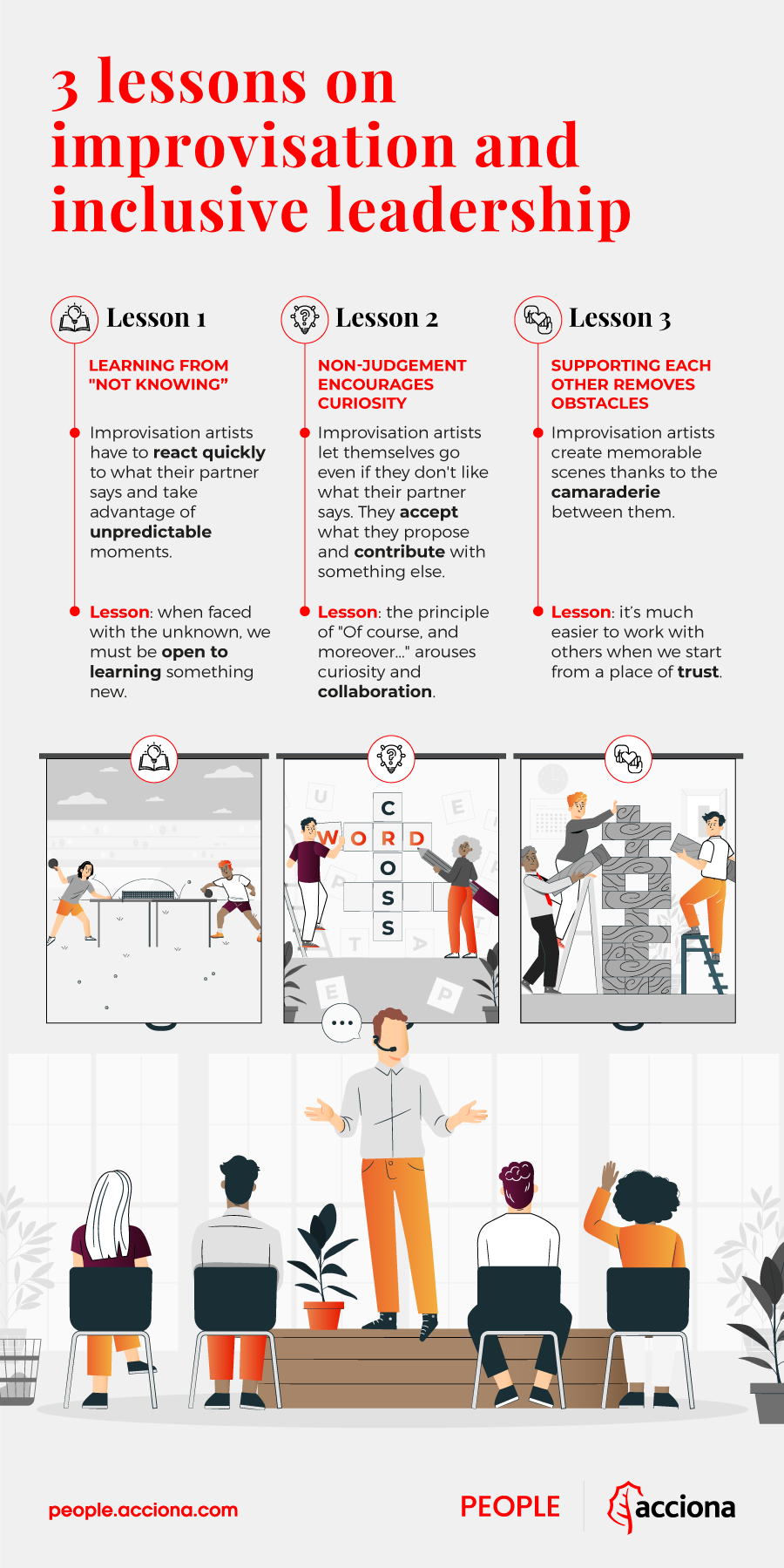In an increasingly diverse and globalised world, organisations require leaders capable of embracing a broad and comprehensive perspective. Inclusive leadership has become a key figure for companies seeking to thrive in this changing environment. But how can an individual prepare to lead a team while challenging their comfort zone by stepping into uncharted territory?
Today we talk about how discomfort is part of the process of professional development, and that learning to be comfortable with it can be the key to unlocking truly inclusive and effective leadership.
What will I read about in this article?
- How to deal with differences with others
- Culture of openness: what it is and why it helps inclusion
- 3 lessons on inclusive leadership
Addressing differences with others through Inclusive Leadership
“It is not our differences that divide us. It is our failure to recognise, accept and celebrate those differences,” said African-American writer and activist Audre Lorde.
This phrase encapsulates a fundamental truth about inclusive leadership and, more generally, about how we interact in our diverse societies. At its core, Lorde’s statement suggests that differences among us – be they gender, race, religion, sexual orientation, physical ability, socio-economic background, etc. – are not inherently divisive. Rather, it is our response to these differences that can create divisions.
With increasingly diverse representation in the workforce, employees bring a wide range of life experiences, cultural norms, perspectives and opinions. And that’s a good thing. Inclusion fosters a better work environment, as we discussed in this article. By valuing and embracing the differences of each team member, it creates a culture of mutual respect and consideration that can improve morale and job satisfaction. In addition, inclusion promotes diversity of thought and ends the dangers of groupthink. When everyone on a team feels valued and included, they’re more willing to share their unique ideas and perspectives.

This can lead to more creative and innovative solutions to business challenges, driving success and growth. But, as Lorde mentions, if not properly addressed, diversity can present challenges in the form of tensions and potential conflicts. When collaborating with individuals who differ significantly from us, there’s a risk of microaggressions, offending or crossing red lines. And that can make us uncomfortable and cause us to tread others carefully for fear of not doing the right thing.
“Diversity can present challenges in the form of tensions and potential conflicts”.
Culture of openness: transparency and empathy key to dealing with discomfort
Many organisations have realised that when it comes to diversity, it’s not enough to build teams of people with different skills, backgrounds or characteristics. Representation alone fails without true inclusion.
Companies that experience the benefits of diversity are those that encourage diversity of thought and freedom of divergent opinions. This requires, as they point out in this Forbes article, a “culture of openness” where people can speak up, ask questions or express their doubts with transparency and empathy.
Sarah Neville, director of Open Line, a company that helps people overcome differences through the power of inclusive communication, is the author of this article. She argues that a conversation can be unpleasant without having to be dangerous. Discomfort is actually a good thing,” says Neville, “it’s a sign that we are growing, trying something new, developing a safer way of approaching what we don’t know.
As we’re encouraged to engage in these difficult conversations, we realise that the experience has not damaged us professionally or personally. Quite the contrary. What happened is that we’ve become increasingly comfortable being uncomfortable.
“Discomfort is a good thing. It’s a sign that we’re growing, trying something new, developing a safer way of approaching what we don’t know”.
3 lessons on inclusive leadership and the power of improvisation
Difference is uncomfortable, unfamiliar and sometimes even unsafe. Whether it is an opinion that’s contrary to our own or a way of working that we’re not used to, the truth is that what separates us can sometimes cause discomfort.
To learn how to manage this, professors in the Inclusive Leadership track of the Harvard Business School MBA did a little experiment. They brought a group of performers from Second City, a Chicago-based improv troupe, into their class, and by watching them perform and work, they gained three useful lessons for anyone interested in becoming a more inclusive leader:
1. Not knowing generates learning
Improvisation artists trade in the currency of unpredictability. They don’t know what their colleagues will say next, how others will react or even when a scene will end. It can even happen that other actors start talking about subjects that the performer knows nothing about.
They work a bit like a game of ping-pong where you have to react in a split second to the ball your opponent sends you. You can try to anticipate his move, but it is best to concentrate on the trajectory of the ball at that precise moment. The same goes for improvisation: you can’t “pong” until the other player has “pinged”.
What lesson did the teachers draw from this? That when others think like us or look like us, we’re likely to be able to predict their movements and perspectives. But when they don’t, we should be open to learning about them.
2. Sparing judgement opens us to curiosity
At the Pixar animation studio, when writers and directors work on a story, group leaders encourage “plussing”, a strategy for improving ideas without using critical language. Instead of critiquing a sketch, the director might pluss by saying, “I like this character’s eyes, and what if…?” Someone else could step in and add their own plus. People listen, respect each other’s ideas and contribute their own. Dissent is welcome, but only when there‘s shared respect and everyone feels they are on the same team.
3. Supporting each other leads to what would otherwise be impossible
There are two key fundamentals of improvisation: trusting our inner voice and supporting others unconditionally. These ideas allow performers to create fun and memorable scenes. It’s much easier to work with others (especially across differences) to shape the future (of a scene, a decision or a collaboration) when we start from a place of trust, knowing that no matter what happens, others will support us.
In short, embracing discomfort is an essential part of inclusive leadership. It helps us to be more empathetic, understanding and effective in our role. It won’t always be easy, but the rewards of a more diverse environment far outweigh any temporary discomfort. So, when you find yourself in an uncomfortable situation, remember: you’re on the right path. You’re growing, learning and paving the way for others to do the same. And that’s what really matters in inclusive leadership.



